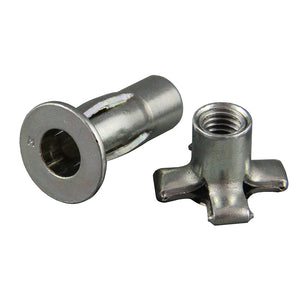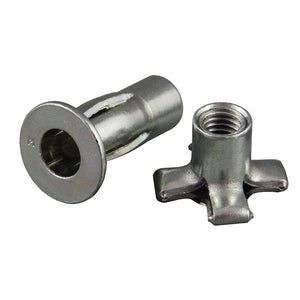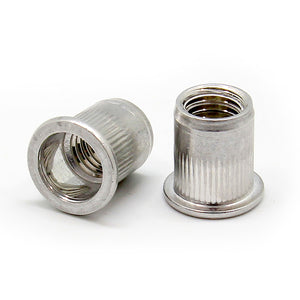-
 Vendor:RivetLab
Vendor:RivetLabM6 Rivet Nuts Steel IN58-0619 - Grip Range: 0.8-3.0mm
Regular price From $13.75 AUDRegular price -
 Vendor:RivetLab
Vendor:RivetLabM6 Rivet Nuts Steel IN9408-0650 - Grip Range: 3.0-5.0mm
Regular price From $17.60 AUDRegular price -
 Vendor:RivetLab
Vendor:RivetLabM6 Rivet Nuts Steel IN9410-0630 - Grip Range: 0.7-3.0mm
Regular price From $30.25 AUDRegular price -
 Vendor:RivetLab
Vendor:RivetLabM6 Rivet Nuts Steel IN9498-0630 - Grip Range: 0.5-3.0mm
Regular price From $14.30 AUDRegular price -
 Vendor:RivetLab
Vendor:RivetLabM6 Rivet Nuts Steel IN9498-0630-CE - Grip Range: 0.5-3.0mm
Regular price From $35.75 AUDRegular price -
 Vendor:RivetLab
Vendor:RivetLabM6 Rivet Nuts Steel IN9498-0650 - Grip Range: 3.0-5.0mm
Regular price From $16.50 AUDRegular price -
 Vendor:RivetLab
Vendor:RivetLabM6 Rivstuds Stainless Steel IN-RS0630S-20 - Grip Range: 0.5-3.0mm
Regular price From $123.75 AUDRegular price -
 Vendor:RivetLab
Vendor:RivetLabM6 Rivstuds Steel IN-RS0630-20 - Grip Range: 0.5-3.0mm
Regular price From $57.75 AUDRegular price -
 Vendor:RivetLab
Vendor:RivetLabM6 Well Nuts Rubber IN-RNM6150 - Grip Range: 0.4-2.8mm
Regular price From $40.70 AUDRegular price -
 Vendor:RivetLab
Vendor:RivetLabM6 Rivet Nuts Steel IN88-0619 - Grip Range: 0.7-3.3mm
Regular price From $16.50 AUDRegular price -
 Vendor:RivetLab
Vendor:RivetLabM6 Well Nuts Rubber IN-RNM6250 - Grip Range: 6.4-11.5mm
Regular price From $52.25 AUDRegular price -
 Vendor:RivetLab
Vendor:RivetLabM6 Well Nuts Rubber IN-RNM6250-ESS - Grip Range: 6.4-11.5mm
Regular price From $165.00 AUDRegular price -
 Vendor:RivetLab
Vendor:RivetLabM6 Well Nuts Rubber IN-RNM6350 - Grip Range: 11.5-23.0mm
Regular price From $58.85 AUDRegular price -
 Vendor:RivetLab
Vendor:RivetLabM8 Plus Nuts Steel INPNS-0807-P - Grip Range: 0.5-7.1mm
Regular price From $73.15 AUDRegular price -
 Vendor:RivetLab
Vendor:RivetLabM8 Plus Nuts Steel INPNS-0813-P - Grip Range: 7.1-12.7mm
Regular price From $77.55 AUDRegular price -
 Vendor:RivetLab
Vendor:RivetLabM8 Rivet Nuts Aluminium IN78-0825 - Grip Range: 1.0-2.5mm
Regular price From $24.75 AUDRegular price
What are Rivet Nuts?
Rivet nuts, also called nutserts or rivnuts, are threaded inserts. Manufacturers design them for installation in sheet metal, fibreglass, plastics, and other composite materials. These versatile fasteners provide a secure and permanent captive thread, making them an ideal solution for various industries. Assembly applications include automotive, electrical engineering, sheet metal, domestic appliances and general fabrication.
Available in different body types, materials, and finishes, rivet nuts cater to a wide range of applications. If you need a strong thread in a thin sheet or a reliable fastening solution, rivet nuts are the answer.
Nutsert, Rivnut, Rivet Nut = Different Names, Same Reliable Product
Customers may give them different names, such as Nutserts, Rivnuts, or Rivet Nuts. However, these terms all refer to the same reliable fastening product.
The Origin of the Term 'Rivnut'
BF Goodrich created the first rivnut in the 1930s and sold it under the trademark Rivnut®. Rivnut is now a trademark of BÖllhoff Inc., USA. However, people often use it as a general term for any blind threaded insert with a body and flange.
How do nutserts work?
A nutsert is a more flexible option than a regular nut. It helps you make strong threads in thin sheets.
This is useful when drilling and tapping might not work well. Once installed, it enables the easy and secure joining of multiple materials with a bolt or screw.
Install nutserts from one side. This makes them extra useful for creating a permanent thread in tubular materials. They also work great when you can access only one side.
How do you install nutserts?
By following these simple steps, you can easily install nutserts using a manual, cordless, or air nutsert gun. Manual rivnut tools are a budget-friendly choice for occasional jobs. In contrast, pneumatic and cordless tools work better for regular use.
- First, thread the nutsert onto the mandrel of your tool of the matching size.
- Next, place the nutsert into the pre-prepared hole in the material.
- As you draw the mandrel into the tool, you securely compress the nutsert.
- After installation, unthread the mandrel and tool from the workpiece.
The result is a strong, load-bearing thread, ready to connect to other materials confidently.
How strong are nutserts?
The strength of a nutsert is determined through a variety of measurements:
- Maximum Tightening Torque
- Pull-Out Strength
- Push-Out Strength
Maximum tightening torque is the force used on the nutsert when installing a bolt or screw. Apply this force before the thread spins or fails under load. Our datasheets provide typical values.
Pull-out and push-out strength refer to the force required to cause the nutsert to fail. This happens when someone pushes or pulls it out of the main material. The strength or rigidity of the parent material itself can also influence this.
How do you install nutserts without a proper nutsert tool?
You can install some nutserts with homemade tools, but we recommend using the right tool for better results. Affordable manual tools are readily available for low-volume installations. For large nutserts or high-volume jobs, a cordless or air tool is a great choice. It helps ensure efficiency and precision.
How do you remove rivet nuts?
Once you install a rivet nut, it stays securely in place. You can remove it by carefully drilling or grinding the head. However, this may risk surface damage or deforming the hole.
Benefits and Applications
Rivet nuts have many benefits. They are easy to install and provide a stronghold. They can handle heavy loads and resist vibration and corrosion.
These attributes make them suitable for various automotive, aerospace, construction, and electronics applications. In industries where welding or tapping is not feasible or desirable, rivet nuts provide an efficient and effective alternative. Their flexibility and reliability have made them popular among manufacturers and engineers, ensuring secure and durable connections across numerous projects.
Rivet Nuts vs. Rivets
Rivet nuts and rivets serve different purposes in fastening. Rivet nuts create a threaded hole for bolts or screws. This allows for a reusable fastening point in thin materials like metal or plastic. These connectors work well for applications that require a strong, detachable connection.
In contrast, rivets create a permanent mechanical connection between materials and install without threads. Once you set them, you cannot remove them without breaking them. This makes them good for projects needing a permanent, non-removable fastening, like aerospace and electronics. You install both from one side, but rivet nuts allow reuse, whereas rivets provide a permanent solution.
Choosing the Correct Rivet Nut
The most important factor when choosing a rivet nut is the grip range. This refers to the thickness of the material where the rivet nut goes. You need to check other attributes such as hole size, material, body style, and flange/head size. Our blog post, 5 Things to Remember to Make the Most of Rivet Nuts, provides additional insights.
RivetLab offers a wide variety of rivet nuts to help you finish your job. This includes specialised types, such as Jack Nuts, Well Nuts, Rivstuds, and Plus Nuts. We guarantee that all our products meet strict industry standards. Manufacturers create them from strong, durable, and high-quality materials.
Install rivet nuts effortlessly with our range of rivnut tools. Discover the perfect tool for your project from our selection.


















